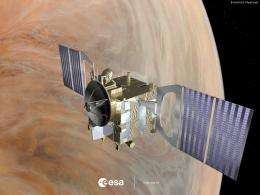Large solar flares generate geomagnetic storm

A pair of unusually large solar flares early yesterday generated a Coronal Mass Ejection that will reach Earth around mid-day today. It will likely cause at least a strong geomagnetic storm that could affect satellites in space and trigger auroral displays.
The effects at ground level are expected to be limited, but there is a good chance for some excellent auroral displays in the north.
The extra-large two solar flares occurred at 23:24 GMT on 6 March and 00:14 GMT yesterday, throwing off a huge cloud of magnetised plasma from the Sun's atmosphere – the corona – into interplanetary space.
These Coronal Mass Ejections (CMEs) often occur in association with a solar flare.
Dramatic events spotted by ESA and NASA missions
These dramatic events were detected by the ESA/NASA SOHO and NASA SDO spaceborne solar observatories. Together with other space organisations, ESA experts are closely monitoring the storm.
The two flares followed an earlier flare, which occurred on 04:05 GMT on 5 March.
All three came from a new active region on the Sun that was first detected on 2 March.
The plasma cloud left the Sun at an estimated 2300 km/s – unusually fast.
However, the angle combined with deceleration from the background solar wind means that it is expected to arrive some hours later than this initial estimated speed alone would indicate.
Satellites to experience increased effects
In addition, a strong stream of high-energy protons has been generated. This 'storm' of subatomic particles was created by the shock wave ahead of the CME.
"It is therefore likely that satellites orbiting Earth will experience increased radiation levels today as a result," says Juha-Pekka Luntama, Head of Space Weather in ESA’s Space Situational Awareness office.
"Space radiation levels are expected to remain high throughout 8 March and possibly for one to two days longer."
"In addition, the arrival of the geomagnetic storm could affect systems including GPS navigation satellite signals and satellite communications."
ESA spacecraft already affected
The Venus Express spacecraft, now orbiting Venus and much closer to the Sun than Earth, was affected by the radiation on 7 March.
The startracker cameras that help Venus Express measure its position and orientation in space were ‘blinded’ starting at 01:41 GMT.
"The Mission Control Team has taken the startrackers out of service and is maintaining the spacecraft's attitude using gyroscopes until the solar effects fade," says Octavio Camino, Venus Express Spacecraft Operations Manager at ESA’s European Space Operations Centre in Darmstadt, Germany.
Alexi Glover, an ESA space weather scientist, says that the solar region causing the current activity has a complex magnetic configuration and is now close to the centre of the Sun's disc.
"So there is a good chance of more large events in the coming days," she notes.
Provided by European Space Agency




















